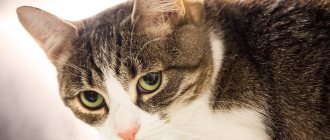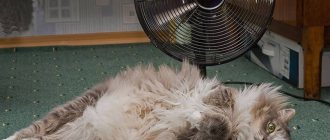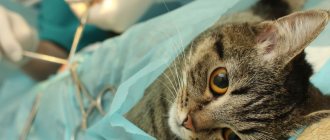Often, thromboembolism in cats develops as a complication that occurs against the background of other, no less dangerous internal disorders. The disease is characterized by acute disruption of blood flow in the vessels, caused by blockage of the artery by a blood clot. The pathology is very dangerous, because a thrombus migrating through the vessels can block the lumen, resulting in paralysis or paresis of the hind limbs, accompanied by necrotic changes in the surrounding tissues.
general characteristics
The owner must clearly understand that the disease in question is a concomitant rather than an independent disease. That is, it develops against the background of various diseases, mainly heart ones, that the cat had or still has.
A blood clot often develops in the left atrium, through which it can travel to the most distant parts of the aorta. As a result, a meowing friend may develop problems in the gastrointestinal tract, brain, kidneys, and also completely lose their hind or forelimbs.
Veterinarians note that thromboembolism can be arterial and venous. They differ in the location of the blood clot. Moreover, blood clots are even more common in veins. This occurs due to the speed of blood flow: in the artery it is very fast, and in the vein it is slow. In addition, arterial vessels have a smooth intima (inner lining), which prevents the formation of clots. On the other hand, a blood clot formed in a vein practically cannot lead a pet to instant death. But the one that arose in the aorta is fine.
Causes
Blood clots can form in blood vessels due to the following factors:
- infection and sepsis;
- poisoning of an animal with toxic substances;
- pathologies of the cardiovascular system;
- oncological diseases;
- the presence of enzymes in the blood;
- mechanical damage to blood vessels;
- previous operations.
It is important for cat owners to know that, according to statistics, these animals more often than others suffer from diseases of the cardiovascular system. Therefore, the formation of clots in arteries and veins is not uncommon for them.
Symptoms of the disease
Experts are convinced that in many respects the signs of the disease are determined by the location of the process. The most striking symptoms of thromboembolism in cats are expressed as follows:
- The cat's coordination of movements is impaired and lameness appears.
- Palpation of the hind legs may reveal paralysis of both legs. At the same time, the muscles on them become like stone.
- The tailed fidget's paw pads are turning pale.
- If a blood clot has blocked the renal arteries, the animal will begin to suffer from pain in the lumbar region and severe vomiting will occur. A blood test may show an increased content of nitrogenous metabolic products.
- Thromboembolism of the mesenteric arteries is characterized by the fact that the pet begins to have diarrhea and vomiting, often with the presence of blood in the discharge. Palpation of the abdomen leads to painful reactions.
- Coma, seizures reminiscent of epileptic and disturbances in the functioning of the vestibular apparatus are signs of a blood clot that is located in the blood vessels of the brain.
- If a blood clot forms in the pulmonary artery, the pet will develop a severe cough and shortness of breath. The mucous membranes turn pale. The pulse becomes weak, and the jugular veins characteristically swell.
Data from statistical studies regarding the survival rate of pets who have developed thromboembolism are extremely disappointing. The presence of a blood clot is aggravated by the entry of ischemic toxins into the blood. Taken together, this leads to multiple development of pathological processes in the animal’s body.
Thromboembolism in cats can only be cured if detected early. A timely diagnosis by a qualified specialist and immediate treatment can minimize the damage caused by a blood clot traveling through the cat’s bloodstream. Otherwise, the risk of death increases with each lost day.
Diagnostic methods
With pronounced clinical symptoms, identifying thromboembolism is not particularly difficult for a doctor. If the signs are not so characteristic, then a number of procedures will help determine an accurate diagnosis. These include:
- Biochemical analysis of the animal’s blood, as well as an additional study of its clotting time.
- Ultrasound of the heart is aimed at assessing the speed at which myocardial contractions occur, as well as how much the atria have increased or decreased compared to normal.
- Angiography is a procedure through which it is possible to identify pathologies in the functioning of an animal’s blood vessels.
What to do if you suspect a disease
Electrocardiography
Thromboembolism of the pulmonary arteries causes acute overload, hypoxia and dystrophy of the right ventricle (acute cor pulmonale) and interventricular septum, the appearance of incomplete or complete blockade of the left posterior branch of the His bundle, incomplete or complete blockade of the right branch of the His bundle. The most common electrocardiographic signs of thromboembolism of large branches of the pulmonary trunk are upward displacement of the RST segment simultaneously in leads III (sometimes in aVF) and V1.2 (less often V3, V4), as well as inversion of the T wave in leads III, aVF, V1-V3. These changes occur quickly (within tens of minutes) and increase during the first days. With a favorable course of the disease, they disappear within 1-2 weeks, only T wave inversion can sometimes persist for up to 3-4 weeks.
Coagulogram (blood test for clotting)
With thromboembolism, a reduction in APTT is observed, PTT and INR are shortened, the concentration of AT III decreases, an increase in the concentration of D-dimer, and an increase in the concentration of RFMC are observed.
Treatment of the disease
How effective the treatment of thromboembolism in cats will be directly depends on how quickly the owners contact the veterinary hospital. If the process has not gone too far, the doctor will definitely try to restore normal blood flow in the animal. The most drastic, but also effective methods include surgery. In this case, the veterinarian opens the aorta in order to free the duct and prevent the occurrence of ischemia.
It is important to understand that this disease itself is only a symptom. Therefore, a specialist needs to eliminate the cause of its appearance, that is, a blood clot. After a blood clot is found, infusion therapy is performed, allowing the blood to remain in the vascular bed. The last step will be to prescribe thrombolytics to your pet - drugs that prevent the formation of blood clots. The dose and intensity of medication is prescribed by a specialist depending on the individual characteristics of the patient.
The owner should be aware that the risk of death during surgery is very high. As an alternative, rheolytic thrombectomy can be used. Its essence lies in the fact that the doctor tries to “break” the clot using a catheter inserted into the vessel. The cat is under general anesthesia at this time. The procedure is very complex, and only an experienced veterinarian can perform it efficiently. But even this does not provide a complete guarantee of recovery; a relapse can occur within 3-4 weeks.
In particularly advanced cases of thromboembolism, when the pet’s body has already undergone the process of tissue necrosis, the best solution would be to stop the pet’s suffering and euthanize it.
Aortic thromboembolism in cats
Aortic thromboembolism or ATE is a relatively common complication of heart disease in cats.
This is very painful and occurs when a blood clot forms in the heart and then travels along the aorta and lodgepole, blocking the flow of blood to one or both of the cat's hind legs.
This causes paralysis of the legs or feet in question and the leg tissue begins to die, causing severe pain. The clot can also form further, causing blockage in the blood vessels that supply the intestines and kidneys.
If you know your cat has heart disease, it is important to know the signs of aortic thromboembolism and act quickly if you suspect your cat is affected.
What causes aortic thromboembolism in cats?
Aortic thromboembolism most often occurs as a result of an existing heart condition or heart disease, and there are three factors that must be present for aortic thromboembolism to develop. This:
- Damage to the endothelium or lining of the heart
- Elevated blood clotting factors
- Pooling of blood in the heart, causing an increased chance of blood clotting
This condition can also be caused in rare cases by other diseases such as kidney disease, bacterial endocarditis, Cushing's disease and liver disease.
What are the signs of aortic thromboembolism in a cat?
The most obvious sign of the condition is a sudden loss of use of the hind limbs, such as limb weakness or general paralysis. The cat will also be in a lot of pain and this will often become obvious as well. Difficulty breathing may accompany the condition due to the additional stress placed on the lungs and heart.
These signs of aortic thromboembolism are often confused with symptoms of a car accident or other serious injury, so very prompt veterinary treatment and a solid diagnosis are essential.
Looking for free pet advice? Click here to join the UKs favorite pet community - PetForums.co.uk
How is aortic thromboembolism diagnosed?
When your veterinarian examines your cat, they will consider the cat's veterinary history and whether they have a known heart condition. Physical symptoms of the condition may include:
- Absent or very weak femoral pulse
- Paralysis or weakness in the hind legs
- Pale paws in light-skinned cats
- Hind legs are cold to the touch
- Tightened limbs
- Abdominal pain
- Heart murmurs
- Loss of bladder or bowel control
Your veterinarian may also run an echocardiogram using an ultrasound scanner and possibly draw blood for panel testing.
Treatment of aortic thromboembolism
Treatment for aortic thromboembolism is unfortunately not possible in all cases, and sometimes euthanasia is the only appropriate option due to the prognosis of recovery.
Even if treatment is successful, it is possible that the condition will recur later. Whether or not treatment is viable will depend on a number of factors, such as the degree of pain and paralysis, as well as the overall health of the heart.
If treatment is indicated, the cat will be given strong painkillers and stabilized until the clot (blood clot) is removed. Removal is usually done surgically, but may involve the administration of strong medications to break up the clot.
The ideal course of action is to support the cat while their bodies break up the clot on their own, using an anticoagulant medication such as heparin and possibly medications that will stimulate the blood vessels to dilate and improve circulation. Recovery is slow and by no means guaranteed, and a significant amount of post-operative care at home is required, even if treatment is successful.
Even if treatment is continued, there is no guarantee that it will be successful, and if gangrene or other complications develop in the hind legs, recovery is extremely unlikely.
Can the condition be prevented?
It is extremely difficult to prevent or reduce the likelihood of developing aortic thromboembolism in cats with heart disease, and even proactive treatments such as heparin therapy are not always effective.
However, cats are often placed on heparin therapy after the first clot to try to prevent later recurrence.
Warfarin therapy, which is usually only used for people with heart problems, is a new treatment that is effective in some cases, but is not without its own risks and requires careful monitoring.
If your cat is known to have any heart problems such as murmur, progressive degeneration or any other weakness, it is important to talk to your veterinarian about the best ways to maintain your cat's quality of life and do everything possible to prevent later problems .
Regular check-ups and monitoring of the condition and its progression are essential so that they know your cat's day-to-day health and condition and act quickly if there are any changes.
How to identify a cat at risk of disease
Our ability to identify a cat at risk for arterial thromboembolism has greatly improved, but this is based on the availability of echocardiography (see table above). Many cats at risk for arterial thromboembolism do not even have auscultatory abnormalities and, while apparently healthy cats are likely not selected for screening echocardiography, most cats presented with arterial thromboembolism will not have a history of cardiac disease. .1,14 Cats with arterial thromboembolism are clearly at risk, as are cats with a visible atrial thrombus or spontaneous atrial echocontrast. Any cat with myocardial disease and left atrial enlargement is at increased risk, especially if left atrial systolic function is impaired. The risk is also increased in cats with left ventricular systolic dysfunction. 11 The short-term risk of thromboembolism for asymptomatic cats with hypertrophic cardiomyopathy and normal left atrial size is probably low.
Preventive actions
As a result of research, veterinarians have found that the average life expectancy of a cat that has undergone surgery to remove a blood clot ranges from 3 months to 2 years. Very rarely, but it happens that the pet returns to its normal life. True, this is the exception rather than the rule. Much more often, a furry friend remains disabled forever, having difficulty moving and meeting his natural needs. Therefore, it is better to prevent the disease than to risk your pet’s health later.
There are no special preventive measures that will effectively protect a cat from blood clots. However, the owner should try to protect the animal from excessively fatty foods. Cats whose diet consists of healthy foods rich in vitamins and microelements get sick much less often. In addition, your cat should be vaccinated on time and given anthelmintic drugs. Such measures will reduce the risk of blood clots developing in the animal’s vessels by a quarter.
Prevention
According to the results of studies conducted by veterinarians, the life expectancy of cats diagnosed with thromboembolism is on average 3 months. up to 1.5-2 years. There is very little chance that a sick pet will be able to return to a full life. Often, the animal remains deeply disabled until the end of its days, unable to move normally and independently cope with its natural needs.
There are no specific prevention methods that can prevent this dangerous disease. If one of the kitten’s parents has been diagnosed with thromboembolism, it is important for the owner to monitor the pet’s nutrition from childhood, monitor the completeness and balance of the food, and prevent the cat from overeating in order to prevent obesity. In addition, it is important to prevent injury to the animal and prevent poisoning by chemicals.










